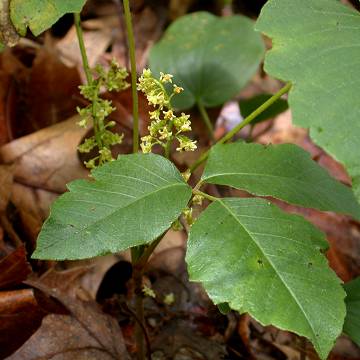

Toxicodendron rydbergii - (image 1 of 5)
Taxonomy
Family: Anacardiaceae
Could be regarded as a variety of eastern poison ivy, T. radicans var. rydbergii (Small ex Rydb.) Rehder. The main differences are the growth habit and ecological niche.
Habitat
Open, sunny habitats. Most common in sandy or rocky soils, including dunes.
Associates
Distribution
Widespread in the west, extending east to the northern U.S. and southern Canada to Nova Scotia and NY, and south at higher elevation to VA and WV. In the Chicago region it is limited to the dunes of Lake Michigan.
Morphology
Simple or sparsely branching shrub, about 1m high, but often only a few inches high, spreading by underground stems or rhizomes, without aerial roots. Leaves alternate, trifoliate, mostly at the top of the stem, glabrous or strigose below and often with a line of minute hairs along the midrib above; petioles elongate, glabrous; leaflets broadly ovate to suborbicular, 5-15 cm long, openly folded along midrib rather than flat, acuminate, margin entire or coarsely toothed, with petiolules, the longest of which on the terminal leaflet. Flowers small and greenish, usually less than 25, less than 3 mm, in loosely branched axillary panicles or unbranched racemes. Fruit a dry, round drupe, ivory to gray, smooth, about 4-7 mm, sessile or subsessile and crowded in a more or less erect inflorescence, persisting into the winter.
Notes
Flowers late May to late June
Wetland indicator: Facultative
Listed as endangered in Ohio. Intergrades somewhat with T. radicans.
References
Gleason, Henry A. and A. Cronquist. 1991. Manual of Vascular Plants of Northeastern United States and Adjacent Canada. Second Ed.
The New York Botanical Garden. Bronx, NY
Swink, F. and G. Wilhelm. 1994. Plants of the Chicago Region.
Indiana Academy of Science. The Morton Arboretum. Lisle, Illinois.
|
Michael Hough © 2005 |